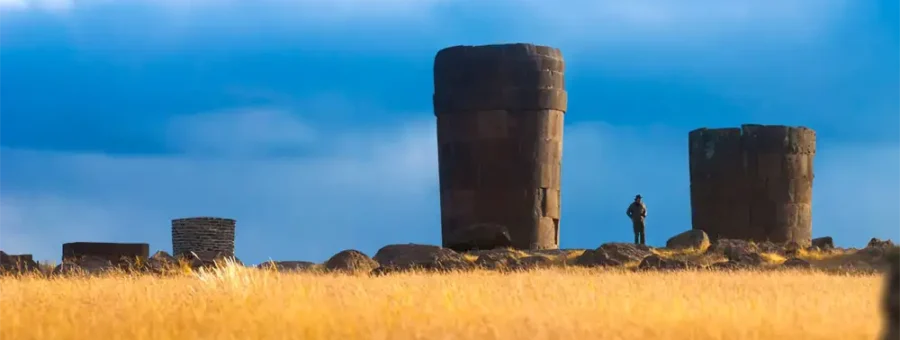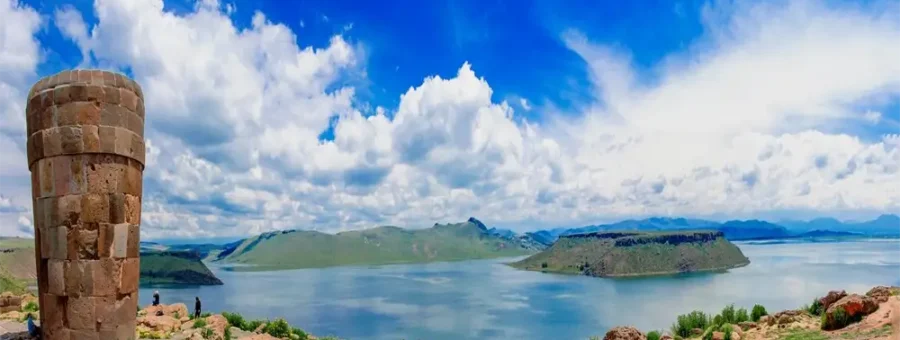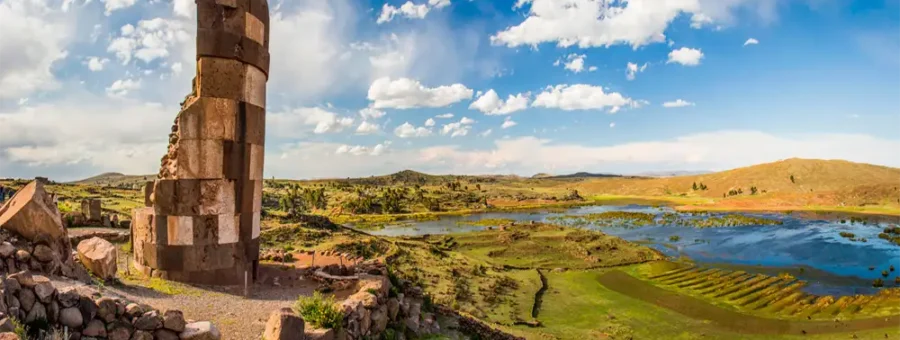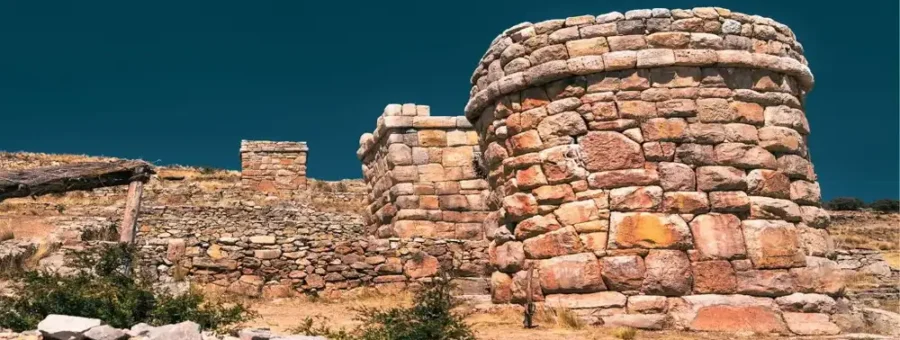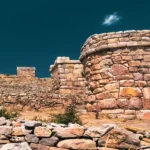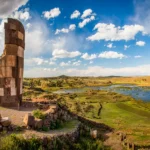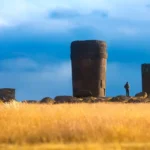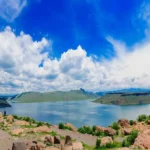DESCRIPTION
The Sillustani Archaeological Complex is one of Puno’s most enigmatic sites, famous for its chullpas, or funerary towers, that reach up to 12 meters in height. These constructions belong to the Kolla (Pre-Inca) culture and were later used by the Incas as burial centers for their nobles.
The site is located on a plateau surrounded by the magical Umayo Lagoon, which makes the landscape a mystical and photographic experience. During the tour, your guide will explain the funerary rituals, the Andean worldview, and the importance of this place as an energetic center.
You will also visit the community of Hatuncolla, where you will learn about the local people’s lifestyle and their ancestral relationship with the land. Near the Chullpa del Lagarto, a royal trousseau containing more than 500 pieces of gold was discovered, now on display at the Carlos Dreyer Museum in Puno.
A tour steeped in history, culture, and Andean landscapes not to be missed.
ITINERARY
Detailed Tour Itinerary
1:30 p.m. – Pickup from your hotel in Puno
The tour begins with pickup from your hotel in downtown Puno. On the approximately 45-minute drive to the archaeological complex, you’ll enjoy beautiful Andean landscapes, agricultural fields of quinoa, potatoes, and barley, as well as small rural communities that maintain their ancestral way of life.
During the tour, your tour guide will provide an introduction to the pre-Incan Kolla culture, which dominated much of the highlands before the arrival of the Incas.
3:00 p.m. – Arrival at the Sillustani Archaeological Complex
Upon arriving at the Sillustani plateau, located at over 3,840 meters above sea level, you’ll find yourself surrounded by a breathtaking landscape: Laguna Umayo, which reflects the sky and the mountains, creating a mystical atmosphere.
The guide will lead us to the archaeological site, where the famous chullpas, or funerary towers, stand. These towers are built with large, perfectly carved stone blocks assembled using megalithic architectural techniques.
Historical explanation: the importance of these constructions as funerary centers for the Kolla nobility and, later, for the Incas will be detailed.
The most notable chullpas include the Chullpa del Lagarto (Chullpa of the Lizard), where the royal trousseau of more than 500 gold pieces was found; the Chullpa de la Serpiente (Chullpa of the Serpent); and other towers that reach up to 12 meters in height.
It will be explained how human remains were found inside, accompanied by offerings such as ceramics, textiles, food, and metal objects, all intended to ensure passage to the afterlife according to the Andean worldview.
3:45 p.m. – Guided walk through the peninsula
We will begin a leisurely walk along the trails surrounding the funerary towers, while the guide comments on the engineering and symbolism of each structure.
From the viewpoints, you will see Laguna Umayo, considered sacred by the ancient settlers.
Along the way, you can observe high Andean birds such as Andean gulls, yanavicos, parihuanas (flamingos) in certain seasons, and even vizcachas on the rocks.
The landscape invites you to take unique photographs, where the funerary towers seem to emerge from the water and the high plateau sky.
4:15 p.m. – Free time at the complex
You will have free time to explore on your own, take panoramic photographs, and connect with the special energy emanating from the site. Many visitors describe it as a mystical and spiritual place, ideal for meditation and contact with nature.
4:30 p.m. – Visit to the community of Hatuncolla
On the way back to Puno, we will stop at the community of Hatuncolla, a traditional village where you can learn about the daily life of the people of the highlands. Here, the guide will explain:
Their farming techniques and llama and alpaca herding.
Their traditional stone and adobe buildings.
The continuity of ancestral customs that continue to this day.
Visitors will be able to interact with the locals, observe their crafts, and learn about the importance of reciprocity (ayni) in Andean community life.
5:30 p.m. – Return to Puno
Finally, we will return to the city of Puno. During the return journey, the guide will be available to answer questions and share additional anecdotes about the history of the highlands. The estimated arrival at the hotel is around 6:00 p.m.
INCLUDES
What’s Included in the Sillustani Tour
- Round-trip tourist transportation from Puno:
Pickup from centrally located hotels in Puno.
Modern and comfortable tourist vehicles with reclining seats.
Professional driver with experience on highland routes.
- Transfer to the Sillustani Archaeological Complex:
A ground trip of approximately 45 minutes with explanations about the high Andean landscapes, crops, and communities during the trip.
- Official entrance to the Sillustani Archaeological Complex:
Tourist ticket included for access to the chullpas and the entire archaeological site.
- Professional bilingual tour guide (Spanish/English):
Comprehensive explanation of the Kolla culture, funerary rituals, the Andean worldview, and the later Inca influence.
Permanent accompaniment during the tour in Sillustani and the Hatuncolla community.
Cultural, historical, and practical assistance (advice, breaks during the hike, assistance for those who need it).
- Guided tour of the Sillustani Archaeological Complex:
Tour of the funerary towers or chullpas, some over 12 meters high.
Detailed explanation of the Chullpa del Lagarto, the most representative of the site.
Walk along the peninsula surrounded by Laguna Umayo, with time for photographs and appreciation of the local fauna.
- Visit to the community of Hatuncolla:
Cultural interaction with the local residents.
Explanation of their daily life, agriculture, and customs.
Opportunity to observe traditional crafts and techniques.
- Continuous assistance during the tour:
Basic first aid kit available on the vehicle.
Guidance from the guide in case of discomfort due to altitude or special needs.
NOT INCLUDED
What’s Not Included in the Sillustani Tour
- Meals During the Tour:
The tour is a half-day tour (in the afternoon), so lunch and dinner are not included. It is recommended to eat a light meal before leaving or bring snacks and water.
- Additional Drinks and Snacks:
Sodas, juices, coffee, or other beverages are not included.
You can purchase them at small stands in the community or bring your own.
- Voluntary Tips:
Tips for the guide, driver, or local residents are not included.
If the traveler wishes, they may leave a donation as a token of appreciation.
- Personal Expenses:
Purchases of handicrafts or textiles in the Hatuncolla community.
Additional services not mentioned in the itinerary.
Telephone calls, souvenirs, or any other personal expenses.
- Transfers from hotels outside the city center of Puno:
If your accommodation is located outside the city center (e.g., hotels on the shores of Lake Titicaca), transfers may have an additional charge, or a nearby meeting point will be arranged.
- Travel or Health Insurance:
The tour does not include medical or travel insurance.
It is recommended to have personal insurance that covers treatment at altitude (3,840 m above sea level).
- Other services not mentioned in the program:
Optional activities outside the tourist route.
Consumables or special requests not listed in the «Includes» section.
RECOMMENDATIONS
Recommendations for the Sillustani Tour
- Previous Acclimatization:
Sillustani is located at 3,840 meters above sea level, so it is recommended to spend at least one or two nights in Puno before the tour to avoid altitude sickness (soroche).
Drinking coca or muña infusions helps relieve mild symptoms.
- Appropriate Clothing:
Bring warm clothing, as the tour takes place in the afternoon and temperatures drop rapidly.
Wear several layers of clothing (polo shirts, a light sweater, a windbreaker or raincoat).
Gloves and a wool hat are useful during the cold season (May to August).
- Sun Protection:
Although the climate is cool, solar radiation is intense in the highlands.
Wear high-factor sunscreen, sunglasses with UV filter, and a hat or cap.
- Comfortable Footwear:
Sneakers or hiking shoes are recommended, as the trail includes dirt and rocky trails.
- Hydration and Nutrition:
Bring water or a sports drink, as the hike and altitude can cause fatigue.
Eat a light lunch before the tour to feel comfortable during the excursion.
- Photography Equipment:
Don’t forget a charged camera or cell phone, as Sillustani offers stunning views of the chullpas and Laguna Umayo.
If possible, bring a power bank.
- Cash (soles):
In the community of Hatuncolla, you can purchase handicrafts or textiles.
Bringing small bills makes shopping and voluntary tips easier.
- Cultural and Archaeological Respect:
Do not climb or touch the chullpas, as they are fragile and protected structures.
Ask permission before photographing local residents.
- Physical Condition:
The tour is suitable for all ages, but walking slowly and taking breaks is recommended if you feel tired due to the altitude.
People with heart or respiratory problems should consult their doctor before the trip.
- Climate:
During the rainy season (December to March), it is recommended to bring a rain poncho.
The sunset in Sillustani is spectacular, but it is usually cold, so dress warmly.
FAQ's
Frequently Asked Questions about the Sillustani Tour
- What time does the tour start and end?
The tour generally takes place in the afternoon. It begins with pickup from centrally located hotels in Puno at 2:00 p.m. and ends at approximately 6:00 p.m., with the return to the city. - Where is Sillustani located?
The Sillustani Archaeological Complex is located 34 km northwest of Puno, on the shores of Laguna Umayo. The trip from the city takes approximately 45 minutes by tourist transport. - What are chullpas?
They are funerary towers built by the Kolla culture and later used by the Incas. Noble figures were buried in them along with offerings of ceramics, textiles, food, and metal objects to ensure their life in the afterlife. - Which is the most important chullpa?
The most representative is the Chullpa del Lagarto, where a funerary trousseau containing more than 500 gold pieces was found, currently on display at the Carlos Dreyer Museum in Puno. - What is the altitude of Sillustani?
The complex is located at 3,840 meters above sea level, so it is recommended to acclimatize to Puno before visiting. - Is the tour physically demanding?
No, the route is easy. It includes short walks on flat trails and some gently sloping areas. It is suitable for all ages, although slow walking is recommended due to the altitude. - What does the tour include?
It includes round-trip tourist transportation, admission to the complex, a professional bilingual guide, and a visit to the Hatuncolla community. Food, drinks, and tips are not included. - Is photography allowed?
Yes, the complex offers spectacular views of the chullpas and Laguna Umayo. It is only recommended not to climb or touch the funerary towers. It is also suggested that you ask permission before photographing the Hatuncolla residents. - Is it cold in Sillustani?
Yes, being on the high plateau, the temperature tends to drop quickly in the afternoon, especially between May and August. Warm clothing and a windbreaker are recommended. - Are there restrooms near the complex?
At the entrance, there are craft stalls, restrooms, and rest areas. There are no restaurants within the complex, so it is advisable to bring water and a light snack. - What wildlife can be observed?
At Laguna Umayo, you can see high Andean birds such as flamingos, Andean gulls, and occasionally vizcachas among the rocks. - Are any local communities visited?
Yes, on the way back, there’s a stop in the community of Hatuncolla, where we’ll explain the daily life of its residents, their agricultural customs, and their handicrafts. - Can this tour be combined with other tours in Puno?
Yes, many travelers combine it with the Puno City Tour or with excursions to Lake Titicaca (Uros, Taquile, Amantaní), depending on time available. - Do I need to book in advance?
It’s recommended to book in advance, especially during high season (June to August), as groups tend to fill up quickly.

